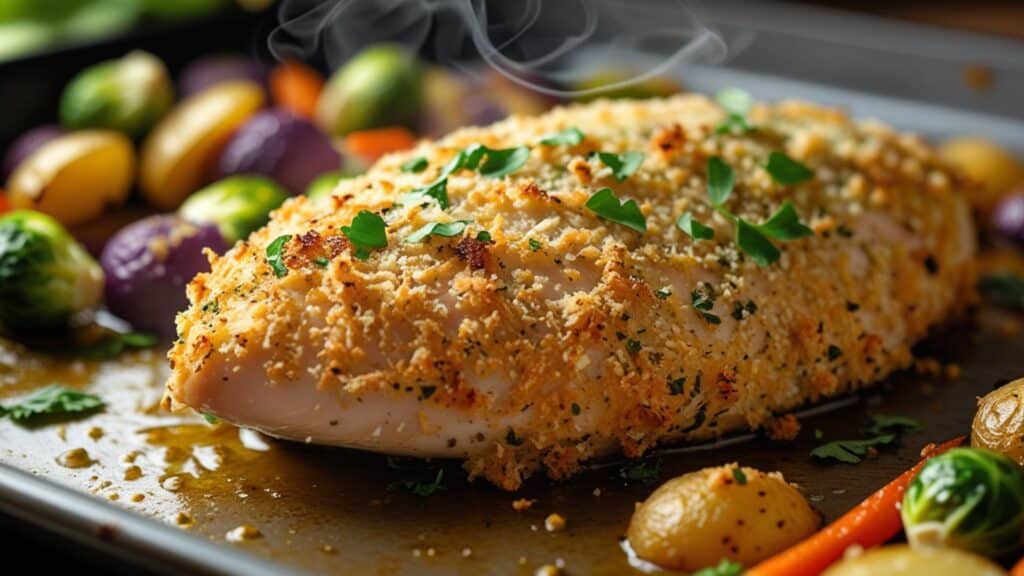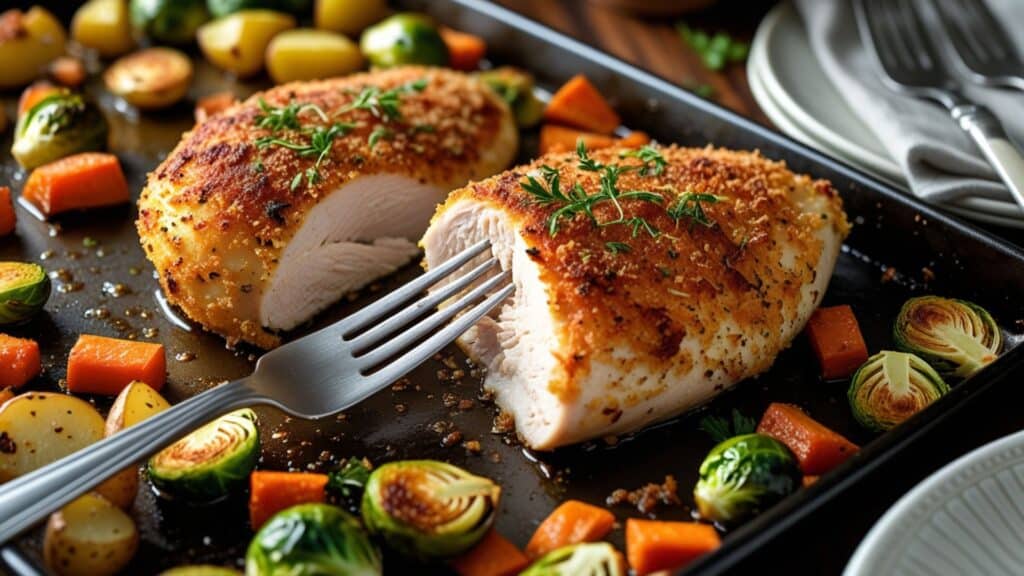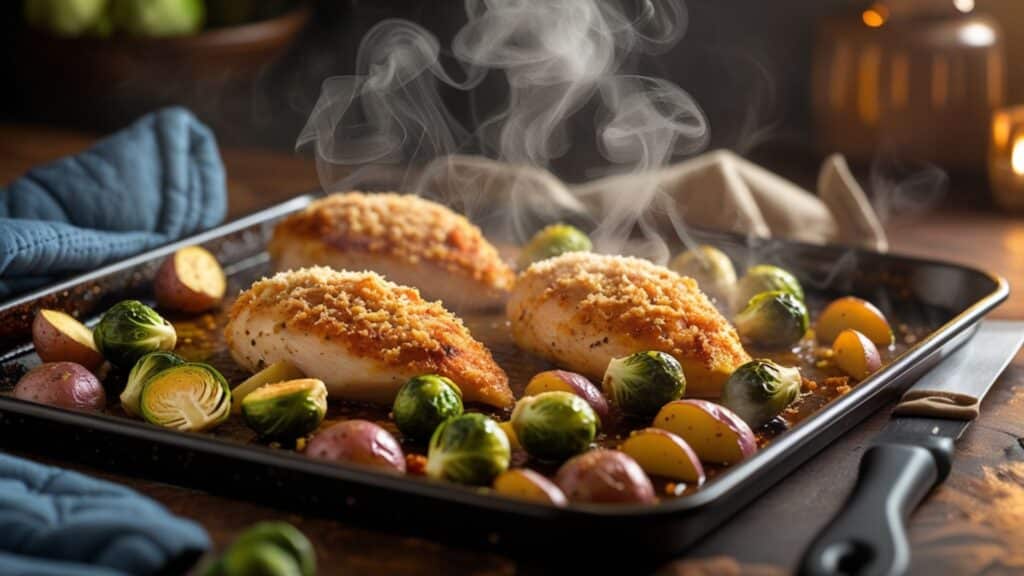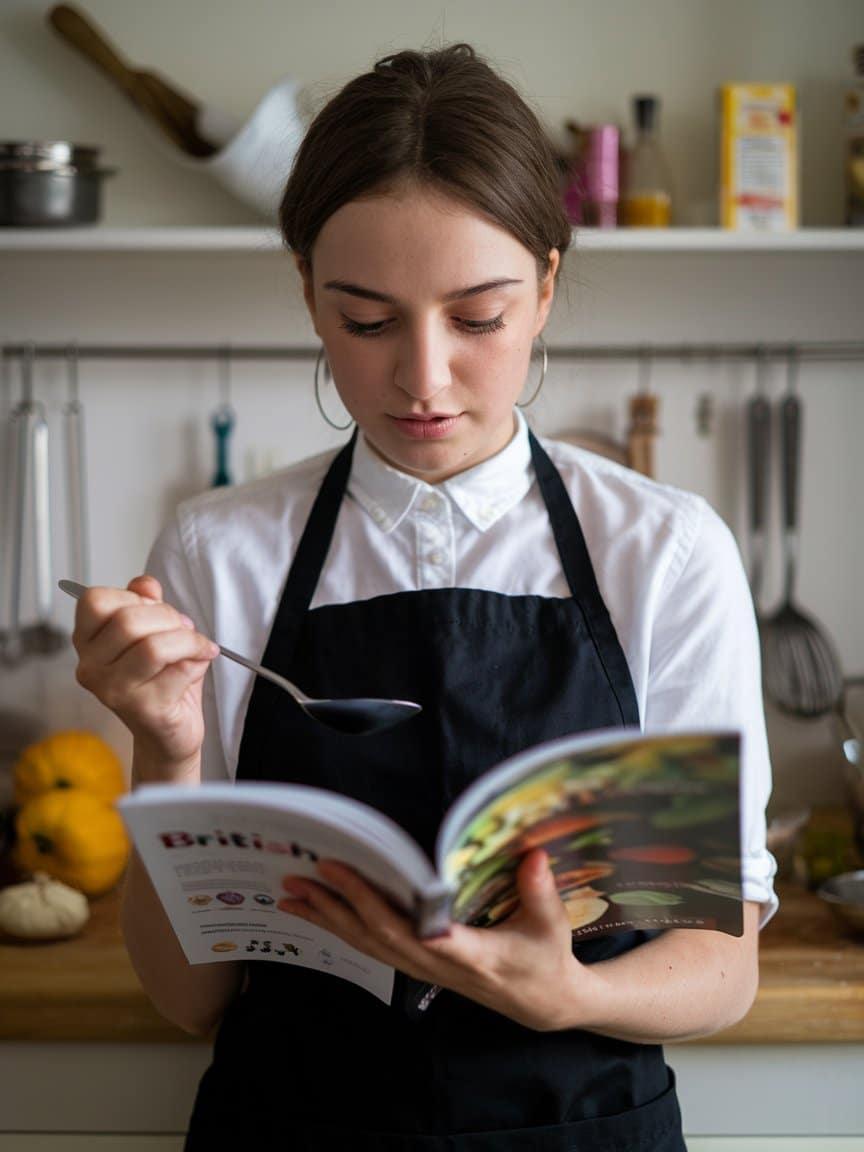Last Tuesday evening, I watched a line cook nearly break down over a forty-top reservation that hit during the dinner rush. Orders were backing up, pans were smoking, and chaos reigned supreme in our kitchen. That’s when our sous chef stepped in with something brilliant a complete chicken dinner that required exactly one sheet pan and delivered restaurant-quality results every single time.
This wasn’t just any sheet pan meal. This was parmesan crusted chicken that emerged from the oven with a golden, crackling crust that shattered at first bite, revealing juicy meat beneath. The vegetables caramelized to perfection alongside, absorbing every drop of rendered chicken fat and herb-infused oil.
What Makes This Recipe Revolutionary
Parmesan crusted chicken sheet pan dinner represents the convergence of professional technique and home kitchen practicality. Unlike traditional breaded chicken that requires multiple steps, dredging stations, and careful oil temperature monitoring, this approach delivers superior results through clever ingredient manipulation and strategic oven positioning.
The magic lies in creating a parmesan crust that actually adheres without traditional breading methods. By combining finely grated parmesan with panko breadcrumbs and binding them with a thin layer of mayonnaise, we create a coating that crisps beautifully while the chicken cooks through gently.
Professional kitchens have embraced sheet pan cooking because it allows precise control over multiple components simultaneously. The technique eliminates the guesswork that plagues home cooks who struggle with timing different elements of a complete meal.
Ingredients & Substitutions
For the Chicken
- 4 boneless, skinless chicken breasts (6-8 oz each)
- 1 cup freshly grated Parmigiano-Reggiano cheese
- 1 cup panko breadcrumbs
- 1/3 cup mayonnaise (preferably Hellmann’s or Duke’s)
- 2 tablespoons fresh lemon juice
- 3 cloves garlic, minced fine
- 2 teaspoons dried Italian seasoning
- 1 teaspoon smoked paprika
- 1/2 teaspoon kosher salt
- 1/4 teaspoon fresh ground black pepper
For the Vegetables
- 1 pound baby potatoes, halved
- 1 large zucchini, cut into half-moons
- 1 red bell pepper, cut into strips
- 1 medium red onion, cut into wedges
- 8 oz Brussels sprouts, trimmed and halved
- 3 tablespoons extra-virgin olive oil
- 1 teaspoon garlic powder
- Salt and pepper to taste
The quality of your parmesan makes or breaks this dish. Pre-grated cheese from a container will not deliver the same nutty depth or proper melting characteristics as freshly grated Parmigiano-Reggiano. The aged crystals in good parmesan create textural contrast in the finished crust.
Mayonnaise serves as our binding agent, and its fat content helps create that coveted golden color. For those avoiding eggs, vegan mayonnaise works surprisingly well, though you’ll lose some of the richness that traditional mayo provides.
Panko breadcrumbs offer superior texture compared to regular breadcrumbs. Their larger, airier structure creates more surface area for browning while maintaining crunch. If unavailable, pulse day-old bread in a food processor, but avoid over-processing into powder.
Smart Substitutions
Chicken thighs can replace breasts for more forgiving cooking and richer flavor. Increase cooking time by 5-7 minutes and check internal temperature reaches 175°F rather than 165°F.
Root vegetables work beautifully in place of the suggested mix. Carrots, parsnips, and sweet potatoes all caramelize well, though cooking times may vary slightly. Cut everything roughly the same size to ensure even cooking.
For dairy-free options, nutritional yeast combined with finely ground nuts creates a surprisingly effective “parmesan” substitute. Use a 2:1 ratio of nutritional yeast to ground almonds or cashews.
Step-by-Step Instructions

Preparation Phase
Preheat your oven to 425°F with the rack positioned in the upper third. This higher heat and elevated position ensures proper browning of the parmesan crust while the vegetables caramelize below.
Pat chicken breasts completely dry with paper towels this step is crucial for proper crust adhesion. Moisture is the enemy of crispy coatings. If your chicken feels particularly wet, let it sit uncovered in the refrigerator for 30 minutes before cooking.
Creating the Perfect Crust Mixture
Combine grated parmesan, panko breadcrumbs, Italian seasoning, smoked paprika, salt, and pepper in a shallow dish. Mix thoroughly to distribute seasonings evenly throughout the coating.
In a separate bowl, whisk together mayonnaise, lemon juice, and minced garlic until smooth. This mixture needs to coat the chicken evenly without being so thick it clumps or so thin it runs off.
Coating Technique
Brush each chicken breast generously with the mayonnaise mixture, ensuring complete coverage on all surfaces. Don’t skip the sides bare spots won’t develop proper crust.
Press the parmesan mixture firmly onto each piece of chicken, creating an even layer. Gently pat and press to help the coating adhere. Some mixture will fall off, and that’s normal.
Vegetable Preparation
Toss all vegetables with olive oil, garlic powder, salt, and pepper in a large bowl. The oil should coat everything lightly without pooling at the bottom of the bowl.
Arrange vegetables on a large sheet pan, leaving space in the center for the chicken. Spread them in a single layer overcrowding leads to steaming rather than caramelization.
The Critical Cooking Phase
Place coated chicken breasts on the prepared sheet pan, nestled among the vegetables but not overlapping. The chicken should sit slightly elevated above the vegetables to allow air circulation.
Bake for 22-25 minutes, rotating the pan halfway through cooking. Internal temperature should reach 165°F when measured with an instant-read thermometer inserted into the thickest part of the breast.
If the crust browns too quickly before the chicken cooks through, tent loosely with foil for the final 5-8 minutes. This prevents burning while allowing the interior to finish cooking properly.
Cooking Techniques & Science
The success of this dish relies on understanding heat transfer and moisture management. Parmesan cheese contains natural enzymes that promote browning through the Maillard reaction, creating complex flavors and appealing color.
Mayonnaise serves multiple scientific functions beyond simple binding. Its emulsified fat content promotes even heat distribution while its acidity from vinegar or lemon juice helps tenderize the chicken surface. The proteins in mayo also contribute to browning reactions.
Sheet pan geometry matters more than most home cooks realize. Heavy-gauge aluminum pans distribute heat most evenly, while dark-colored pans absorb more heat and can lead to over-browning. If using a dark pan, reduce temperature by 25°F.
Understanding Vegetable Cookery
Different vegetables require strategic placement for optimal results. Dense vegetables like potatoes need direct contact with the hot pan surface, while more delicate items like zucchini should sit slightly elevated to prevent overcooking.
The rendered chicken fat that drips onto the vegetables during cooking adds incredible flavor depth. This natural basting effect is why sheet pan meals often taste better than their individual components cooked separately.
Temperature Mastery
Oven hot spots can sabotage even perfect preparation. Rotating the pan halfway through cooking compensates for uneven heat distribution in most home ovens. Professional kitchens use convection settings to circulate air, but standard home ovens benefit from manual rotation.
Common Mistakes and Solutions
The most frequent failure involves soggy crusts caused by inadequate drying or overcrowded pans. Always pat chicken completely dry and leave adequate space between pieces for air circulation.

Under-seasoning the vegetables is another common pitfall. Vegetables need more seasoning than you think because they’ll lose some flavor during the high-heat cooking process. Season generously, then taste and adjust.
Timing mishaps plague many home cooks attempting sheet pan meals. Cut vegetables uniformly and arrange according to cooking requirements denser items toward pan edges where heat concentrates.
Serving & Plating Suggestions
This dish shines when served family-style directly from the sheet pan, but restaurant-style plating elevates the presentation significantly. Warm your serving plates in a 200°F oven for 3-4 minutes before plating.
Arrange vegetables artfully on one side of the plate, creating height and visual interest. Slice the chicken breast diagonally and fan it alongside the vegetables, showcasing the golden crust and juicy interior.
Complementary Flavors
A simple arugula salad dressed with lemon vinaigrette cuts through the richness beautifully. The peppery greens and bright acid balance the savory parmesan and roasted vegetable sweetness.
Crusty bread serves dual purposes sopping up the delicious pan juices and providing textural contrast. Warm focaccia or ciabatta work particularly well.
For wine pairings, choose something with enough body to stand up to the parmesan’s intensity. A Chianti Classico or Côtes du Rhône red offers complementary earthiness, while a crisp Sancerre provides bright contrast if you prefer white wine.
Creative Variations
Mediterranean versions incorporate olives, sun-dried tomatoes, and fresh herbs like oregano and thyme. Replace Italian seasoning with herbes de Provence for a French twist.
Spicy adaptations benefit from cayenne pepper in the crust mixture and jalapeños among the vegetables. The parmesan helps temper the heat while maintaining flavor complexity.
Autumn versions substitute root vegetables and add fresh sage to the coating mixture. The herb’s earthy quality pairs beautifully with parmesan and caramelized vegetables.
Professional Tips for Home Success
Investment in a good sheet pan pays dividends in cooking performance. Half-sheet pans (18×13 inches) provide optimal space for four chicken breasts and adequate vegetables for a family meal.
Parchment paper isn’t necessary but can simplify cleanup. If using parchment, choose a brand rated for high temperatures to prevent burning at 425°F.
Resting the finished dish for 5 minutes before serving allows juices to redistribute and prevents the crust from sliding off when sliced. This professional technique ensures better presentation and eating experience.
Troubleshooting Guide
If your crust isn’t browning adequately, move the pan to a higher oven rack for the final 5 minutes of cooking. The increased distance from the heating element promotes better browning.

Dry chicken results from overcooking or starting with overly thin breasts. Pound thicker breasts to even thickness or butterfly them for more consistent cooking.
Soggy vegetables indicate overcrowding or insufficient oil. Vegetables need space to caramelize properly, and adequate fat helps achieve proper browning.
Conclusion
Parmesan crusted chicken sheet pan dinner represents the best of modern home cooking sophisticated flavors achieved through simple techniques and smart ingredient choices. The combination of crispy, cheesy coating and perfectly caramelized vegetables creates a restaurant-quality meal that requires minimal skill but delivers maximum impact.
The beauty lies in its adaptability to seasonal ingredients and dietary preferences while maintaining the core appeal of one-pan convenience. Whether you’re feeding a weeknight family dinner or entertaining guests, this technique provides consistent, impressive results.
Master this foundation, and you’ll have a template for countless variations that will keep your dinner rotation exciting while your cleanup minimal. The professional techniques embedded in this seemingly simple recipe will elevate your entire cooking repertoire.
Remember that great cooking comes from understanding your ingredients and respecting the process. Take time to properly dry your chicken, cut vegetables uniformly, and monitor cooking progress. These small details separate good home cooking from truly exceptional meals.
Frequently Asked Questions?
Q: Can I prepare the chicken coating in advance?
A: Yes, you can coat the chicken up to 4 hours ahead and refrigerate uncovered. This actually improves crust adhesion as the coating firms up. Add 2-3 minutes to cooking time if starting from cold.
Q: What if my parmesan crust is browning too quickly?
A: Create a foil tent over just the chicken pieces, leaving the vegetables exposed. This slows browning while allowing the interior to finish cooking. You can also reduce oven temperature to 400°F and extend cooking time by 5-7 minutes.
Q: How do I know when the vegetables are properly caramelized?
A: Look for golden-brown edges and slight char marks on cut surfaces. They should be tender when pierced with a fork but still hold their shape. Properly caramelized vegetables will have concentrated flavors and appealing color contrast.
Q: Can I use frozen vegetables for this recipe?
A: Fresh vegetables work best, but if using frozen, thaw completely and pat dry thoroughly. Increase cooking time by 8-10 minutes and expect slightly less caramelization due to higher moisture content.
Q: Why does my chicken sometimes turn out dry despite following the recipe?
A: Chicken breast size varies significantly. Use an instant-read thermometer and remove from oven immediately when internal temperature reaches 165°F. Carryover cooking will bring it to the perfect final temperature during resting.

Veronica is a passionate food enthusiast with over three years of experience in exploring and writing about diverse cuisines. Her expertise lies in reviewing restaurants, sharing creative recipes, and discovering the latest food trends. As the voice behind FoodieRecap.com, Anju brings fresh perspectives and culinary insights to her audience.
